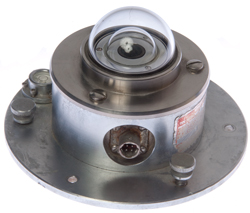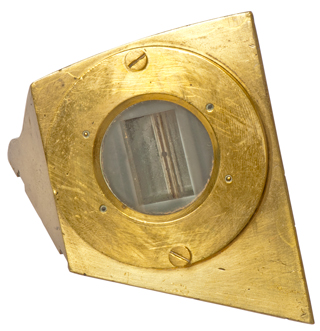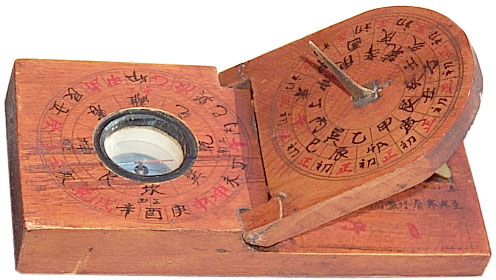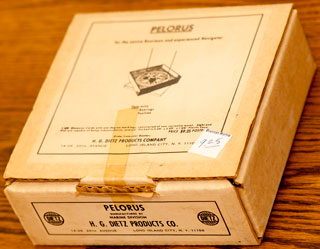Sundials
© Brooke Clarke 2000 - 2013
Background
My Dials
Campbell Stokes Sunshine Recorder
Eppley Pyranometer
Eastern Science Supply Co.
Heliostat
Schmoyer Sunquest Dial
Direct Reading Equatorial
Satellite Sun Blockage Ceiling
Dial
Satellite Sun Blockage
Dipleidoscope
Chinese Sundial & Comapss
Indoor analemma -
f/100 Lens
Pelorus
Universal Sun
Compass
To be Added
Organizations
Calculations
For Sale
Construction
Stained Glass
Descriptions
Home Pages
Books
Heliograph
Heliostat-Patents
Patents
Gnomonics
MyRelated Web Pages
Links
Background
Once I discovered sundials the first thing that I was curious about
was how accurate could a dial be.
The answer is that it can be accurate to one second of time if
provision is made to customize the dial for each year. I still
have ideas about how to make a dial that would be very accurate by
virtue of having a way to set which of the four years in a leap year
cycle was the current year. For example consider a noon mark
(a sundial that only tells when it is noon local time). If
instead of showing the mark as a line use circles to represent the
image of the Sun at exactly noon. If some optical system could
be used to make the Sun's image very small then maybe the images for
different years in a four year cycle could be separated. One
factor to recon with is the insertion of leap seconds. This is
done to keep UTC in line with astronomical events.
In the past the USNO observed stars with the Photographic Zenith
Tube to determine what time it was. This system had an
absolute accuracy in the millisecond range. Now they use
Very Long Baseline Interferometry (VLBI) to set the time.
This is done on a world wide basis. Use the link to
the IERS on my Time & Frequency
page for more informatio.
My web page on Stellar Time
considers how accurate you can get using stars.
Land surveyors have used the Sun to determine a North - South
bearing with great accuracy. To do this they need to know
their location and very accurate time. This requires special
adapters on the surveyor's transit. This process could be
used in reverse to determine time.
Pinhole Astrophotography - For the best resolution a pinhole
of diameter d (mm) should be 745*(d^2) mm away from the image.
My Dials
While not really a sundial, it is very much related to studying
the sun.

|
There is a setting for latitude so the main
axis is aligned to the celestial north pole.
A special paper is installed in a slot depending on the
season of the year.
The sun burns a trace when it's shining.
|
This is an instrument with pretty much the same function as the
above Campbell Stokes Sunshine Recorder
except it makes the measurement electrically.
While not really a sundial, it is very much related to studying
the sun.
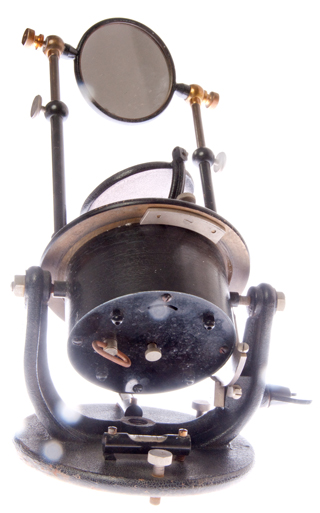
|
A clockwork turns the lower mirror to
follow the sun.
The rotation axis needs to be set for the local latitude
and aimed at the North celestial pole.
This can be done by using a leveled surface and leveling
the base by means of the level vials then rotating the
unit when set to the correct time until the sun points
along the rotation axis.
See Heliostat patents below.
If you have any information on this ESSCO unit please contact me.
|
Schmoyer Sunquest
Dial
I first learned about this dial from Fig 4.4 in the book
"Sundials: Their Theory and Construction"
by Albert Waugh, 1973. But they were no longer in
production.
After he died his daughter offered the casting kit and I got
one.
Today there's an entry on the Precision Sundials web page for
the Schmoyer.
I shipped a couple
of parts to Tony Moss in England for machining.
This is the most critical step. |

|
|
|
Direct Reading
Equatorial
Spiral Design Inc., Boulder, Colorado made this dial.
It can be adjusted for latitude using the clamp bolt to rotate
the main support ring and adjusted for longitude (and DST) by
moving the calibrated time scale (magnetically
attached). There are two Equation of Time
Corrected Gnomons. They serve the same purpose as
turning the Schmoyer Gnomon, but that means you need to store
the one that's not being used.
The short pin on the lower gnomon support rod needs to be
turned so it points to the Sun to get the correct Equation of
Time (Wiki)
correction.
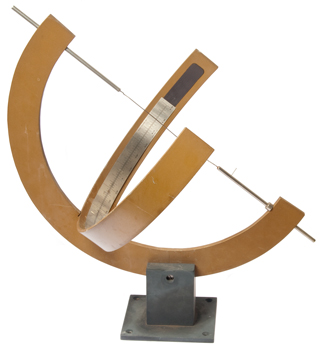
The black band just above the time scale is the magnet.
|
 |
Satellite Sun Blockage Ceiling Dial
 I
use Starband for my internet connection. It's a two way
satellite based system. At my house there's an orange peel
type offset fed dish that has both a receiver and a
transmitter. It's very similar to the Ku band receive only
satellite TV receiver dish and this idea would work for them also.
I
use Starband for my internet connection. It's a two way
satellite based system. At my house there's an orange peel
type offset fed dish that has both a receiver and a
transmitter. It's very similar to the Ku band receive only
satellite TV receiver dish and this idea would work for them also.
Using a 3'x5" card with an elicipse
about the same size as the sun's image with a hole in the center
to mark the sun's position on the ceiling. And the Starband
signal strength window displayed on my computer screen. When
the signal gets down to 6.0 (it's normally between 7 and 8.5) one
mark is made. Then another at 5.0. A yellow
highlighter is used to emphasize the range between 6.0 and
5.0. When the signal gets down to 4.8 my system shuts down
totally.
I don't yet understand why the 4 Oct
2004 marks don't line up with the March 2005 marks.
(it very well have been that the mirror got moved!)
All the sun blockage marks are around
12:45 PST in the spring and 1:40 PDT in the fall (and to the left
of them is a mark made at 1:00:00. I have added dates to the
left of the 1:00:00 line to make them easier to read. For a
reason that I don't understand my camera does not want to focus on
the ceiling.
On 4 March 2005 I drew the sun's
outline to give the diagram some scale. Note that the sun
moves it's own diameter in about 2 minutes.
29 April 2005 - I have been marking the ceiling at 12 and 1 PST and
when PDT started I added the new 12 and kept what's now 1 and 2
PDT. A couple of observations:
(1) I should have placed the mirror as close to the window as
possible to get sun on the mirror for dates closer to winter
solstice. As it is now (27 Apr) I can no longer mark the
2 PDT spot because the rain gutter is shadowing the mirror.
(2) I should not have used double sided tape to attach the mirror
since it can be moved after sitting in the sun because the sun
softens the tape/glue. Also the tilt can be changed enough t
move the spot maybe 3 sun diameters. Better would have been to
use an epoxy to attach the mirror and I'm not sure about a preferred
tilt or tip angle, but there may be a desirable angle other than
just leveling the mirror.
2 May 2005 - By pushing down or lifting up on the wooden window sill
it can be deformed enough to move the sun's spot on the ceiling a
couple of sun's diameters. When released it seems to be back
to where it started. But there may be some temperature
dependence that would be hard to detect. In the process of
epoxy application the mirror down, but first have put 3 small
pieces of paper putty under mirror and have set the mirror so that
at noon PDT the spot is in line with the prior data points.
Tomorrow if it's still in line then I'll add epoxy.
11 May 2005 the sun now is shadowed by the rain gutter. Should
have placed the mirror as close as possible to the window to get
some more days. The Sun does shine on the mirror earlier than
noon.
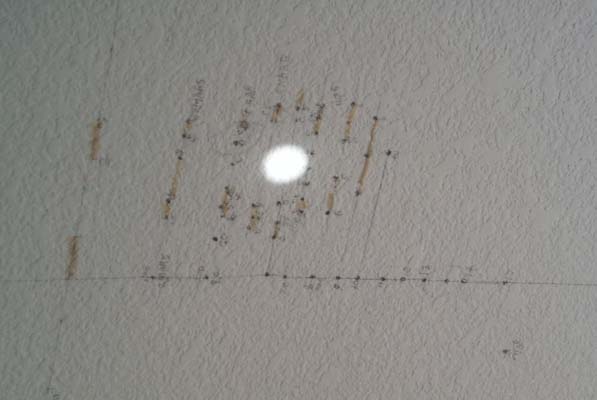
4 Oct '05 Sattelite blockage. Correlation with signal strength
numbers was execllent. The blockage area was drawn about 6
months ago.
The line at the bottom was drawn at 1:00 PST and now it's 6 months
later so it's on the wrong side of the Analemma . The Sun
crosses this line on 4 Oct '05 at 1:38 PDT.
10 Dec 2005 - Problems with marking the ceiling in December at
12:00:00 PST are rain or cloudy days result in no mark and when it's
sunny the Sun is low and into the trees. This causes the spot
of light on the ceiling to be an image of the trees rather than of
the sun, not so easy to fit onto the 3x5 card with nested ellipses.
The dipleidoscope was developed in the 19th century to
use mirrors and a clear glass plate to determine noon to within
10-15 seconds. Fred Sawyer's daughter made one out of
mirrors as a science project. Fred also has an original Dent's
Dipleidoscope in his collection. The June 1993 issue of the
Bulletin of the British Sundial Society (93.2) includes an article
"High Noon" by Charles Aked on the theory of the dipleidoscope.
The UK patent dated A.D. 1843 No. 9793 was filed by Mackenzie
Blozam and titled "Meridian Instruments."
A how to make article appeared in the book "The Amateur
Scientist", printed in New York in 1960 or so. The purpose
was to determine the orbital period of Earth Satellites on
successive rotations by noting the time they passed through a
fixed azimuth. The main components are (1) a horizontal
first surface mirror, (2) a second first surface mirror with
it's rear edge raised so that the angle between the mirror faces
is say 140 degrees, (3) an optical flat that's been silvered to
about 38% of the light is reflected. This glass flat if
placed over the two mirrors so when viewed from the side the
three components form a triangle.
When a heavenly object if viewed there will appear two images,
one from the silvered glass plate and the other is causes by a
double reflection by means of both mirrors. As the azimuth
of the object changes the two images will merge and at one point
will be coincident, this is the time to mark.
The Amateur Scientist dipleidoscope is intended for viewing
with the eye. The Dent patent covers both naked eye units
and one with a built in telescope.
based on the I Ching and used for classical compass school Feng
Shui
Indoor analemma on floor (brass
tacks) with Aluminum plate in skylight with hole - F/100 Lens
I used this in a noon mark made by drilling a hole in an aluminum
plate located at the bottom of a south facing sky light. To
determine the hole size I first tried various holes in
cardboard. A starting point is that a pin hole camera would
have an "f" number of 100. That is the hole diameter would
be 1/100 the focal length (or distance to the dial). If the
hole is smaller the image is dimmer, as the hole gets larger the
sun's image gets more fuzzy. The image was an ellipse since
it was projected on a wood floor. I had a stiff piece of
3x5" paper with a number of ellipsis and a small hole in the
center. Using a watch synchronized to WWV and the beeper
turned on, I tracked the sun's image and stopped when the watch
sounded. Then just drive in a brass tack.
This took many years to get all the noon marks.
Note (AFAICR) the tack for noon on the same date in different
years was typically more than a brass tacks head diameter away
from prior years although closer to prior years than different
dates. Caused by the leap year cycle that lasts four
years.
Pelorus (Wiki)
This has an appearance similar to the Abrams Universal Sun
Compass SC-1.
This one was made by Dietz. When zero degrees is sighted
on the North Star then the degree wheel can act like a
compass. Wiki calls it a "dumb compass".

To be Added
Prototype for 8.5" by 11" flat paper dial
Ring Dial
Combined 2-types of dial that is North finding
Universal Dial
Combined magnetic compass and simple dial
My accurate design Noon Mark
with both PST and DST (1 week overlap) - back board adjusted to
be South facing
Organizations
British
Sundial Society (BSS)- Publications -
How to join your
national sundial society -
Epact
- electronic catalogue of medieval and renaissance scientific
instruments
Fer de Vries
(Dutch Sundial Society) - THE reference page although some are
Dutch - Mayura Draw - DeltaCad - for files conversion
Greenwich 2000 -
Long Now Foundation
- 10,000-year Clock - New
Scientist article -
Martian
sundial
designed for 2001 space mission -
Museum of the History of
Science, Oxford -
DOC - National Oceanic and Atmospheric
Administration (NOAA) - Sunrise/Noon/Sunset
Calculator -
North American Sundial Society
(NASS)-
Scientific Instrument Society
- to bring together people with a specialist interest in
scientific instruments, ranging from precious antiques to
electronic devices only recently out of production.
Society for
Interdisciplinary Studies - G.F. Dodwell study of gnomons?
Sundial
Mailing List - Sundial
Mailing list Graphics page -
Univ of Tokyo -Cosmology
-
University of
Wisconsin - River Falls - Richard D. Swensen Sundial
- Design -
Calculations
Analemma
Applet -
Analemma - an explanation
& sun graph to plot yours
Arnold Moy's HP48 Home
Page - Calculator program to show the Sun's illumination of
the Earth
Astronomical
programs at the Oakland.edu site
Astroware 1 CD-ROM -
Cadastral Survey -
Dialist's
Companion - Dialing computer program
Disney
World FL Sundial - SunPath Designs -
Florida Solar Energy Center
-
Frequently
Asked
Questions about Calendars -
LJ Coletti - Web
calculators
MapBlast -
Mapmaker - World Map showing the Day-Night
terminator -
Microwave
Telemetry - uses sunrise and sunset time to calculate
position of bird or fish
AstronomyAnswerBook:
The
Position of the Sun
Richard B. Langley - Geodesy and
Geomatics Engineering page -
Sky & Telescope's - Astronomical
Software
Menu -
Solar Calculator -
Sundial Generator
-
Sun API
- by David Pratten - does a lot of calculations relating to the
Sun's postion
Sundial
Generator - by Jordan Schwartz
US Census Bureau - Tiger
Mapping Service -
USNO Astronomical
Applications Department - Earth's
Seasons -
Virtual
Visit - software
- Shadows 1.5
-
For Sale
Analemmic-Equatorial
Sundials - by Pete
Swanstrom - heliochronometer
Ames
Instrument Company - Universal
Ring Dial -
Antique
PocketSun
Dials -
Artisan Industrials
- Spectra
Sundial - A prismatic windowsill sundial
Blades of Tara
- has many dials
-
BSS Sundial
designers and makers -
Cast Bronze Armillary
Sphere Sundial -
Celestaire - Pelorus
Compass - both old and new - Books on
sundials, longitude & navigation -
Classic Science -
recreations of classic instruments $400 to $3000 range
Colonial Brass Company
-
Connoisseur Sundials -
Courtyard Sundials,
UK -
Daniel Oberti Garden Oriented Artifacts - Sun
dials
& Moon disks -
Digital Sundial - - Patents
-
Flowton Dials
- both dials and instruments for making dials
GEOMARK(TM)
Personal
Location Marker -
Gunning - heliochronometer
Helios -
Elegant German dials
Kate
Pond - Odyssey
Of
Light Is Installed - crossing beams of light from
cylindrical mirrors
Kenneth Lynch & Sons'
- #1505
& #2599
-
Merlin
Design - etchers in brass
Metalwork at Penobscot Creet Farm
- Large
Custom Sundials -
Moonstick - slide rule
that can calculate the moon phase for any date, past (8000 years),
present, or future (8000 years).
Morrison Associates -
has lost the gnomon pattern for the Schmoyer sundial - but did pay
for a replacement patern.
Personal
Astrolabe -
Precision Sundials
- Renaissance
Focusing
Sundial - heliochronometer
Real Goods - Solar energy
supplies also in Mendocino county
Saunders and Cooke
Antique Re-Creations -
SON Manufacturing Co.
- Compass Dial -
Stanley London - a
California company offering reproductions
Sundial Fair -
shops with common advertising
Sundials
- made to measure -
Sunpath Designs -
SUNWATCH UHRI -
nice Swiss design
Tony Moss -
Lindisun Sundials
Ulysse Nardin watches
- Trilogy - Astrolabium - astrolabe in
a wrist watch -
Wenger Sundial -
Wind & Weather -
carries many nice sun dials (in Mendocino county like me) -photo
of Dual Water Tank store in
Mendocino - moved to Fort Bragg
Construction
Rayzist
- photo resist for abrasive blast
UltraPro
-
The Event Inventor
-
Useful
Inventions for Hiking - including using your hands as a
Sundial by Karen Robinson
Other Dials
Cambridgeshire
sundial
trail - Royal Greenwich Observatory Sundial -
in The
Netherlands -
Sundial pendants
-
Compass
with
pocket string sundial -
Hewlett-Packard
PA-7300LC
microprocessor -
Chinese
Sundial -
Sundial List Server Image
Page - Equatorial Heliochronometer by John Carmichael -
Die
HALBE
- ACHT - Sonnenuhr - a new type of dial?
Stained Glass
There are a number of ways that
stained glass can be incorporated into a dial:
- The glass might be used as a surface treatment for a
conventional type of dial
- The glass would form a translucent dial face where the
style was on the outside of a building
- The glass would form an image that would be projected onto
a special area on a floor or wall or using a mirror to
almost anywhere.
Descriptions
Information
Leaflet
No. 71: `The Tercentenary Sundial -
Information
Leaflet
No. 75: `The longitude of Greenwich -
The
Invention
of the Chronometer - US PTO article in bottom 1/3 of page
Sun
Compass - used in WWII Africa SC-1 manual
front cover,
Evolution of
the Sextant -
'Magic'
Viking Sunstone Just Natural Crystal - calcite crystal,
called an Icelandic spar
Home Pages
Angelo
Brazzi -
Atmospheric
Optics - Rainbows, etc.
Bernard Droege -
Daniel Roth
- links
- German home page - sponser of the mailing list
Deux cadrans
analemmatiques à heure légale - analemmatic sundials for
legal hours - Bonjour et
bienvenue sur ce site - with some pages in English
Electric
Astrolabe - this could get habit forming - The
Astrolabe - Astrolabe
Links and References - links-
Fred Sawyer's list of links -
Gordon T. Uber Sundial
page
Grzechnik Sundial page
-
Hours and Unequal
Hours by Nicholas Whyte
Internet
Sundial web Ring - just press "next" at the bottom of each
page
Jack Aubert -
Sundial
Theory -
Jim Lattis -
Jordan Schwartz
-
Olbers-Planetarium
Bremen - German site moon dial?
Robert Terwilliger -
Sundials - Randolph AFB Sundial
- Bob is restoring the AFB dial
Sundial
site
of Frans Maes -
Sundial Sculptures
of Stone and Brass - by John L. Carmichael Jr. At what point
does a sundial become a heliochronometer?
UAI
-
Sundails Section - Italy
Books
Sundials,
Their
Theory and Construction by Albert E. Waugh, Dover
Publications, ISBN 0-486-22947-5 - This is the classic sundial
theory & construction book.
A
Choice of Sundials by Winthrop W. Dolan, Stephen Greene
Press, ISBN 0-8289-0210-0
Sundials
Their
Construction and Use by R. Newton Mayall & Margaret W.
Mayall, Sky Publishing Corp., ISBN 0-933346-71-9
Sundials
How
to Know, Use, and Make Them by R. Newton Mayall &
Margaret W. Mayall, Sky Publishing Corp., Lib of Congress #
73-76242
Astronomical
Formulae
for Calculators by Jean Meeus, Willmann-Bell, Inc. (math books)
ISBN 0-943396-09-3
Practical
Astronomy
with your Calculator by Peter
Duffett-Smith, Cambridge University Press, ISBN 0 521 28411
2
Astronomy
with
your Personal Computer by Peter Duffett-Smith ,Cambridge
University Press, ISBN 0 521 31976 5
Mathematical
Astronomy
Morsels -
Making A
Clock-Accurate Sundial Customized to Your Location by Sam
Muller
BSS book list -
Heliograph (Mk.
V)
Combines a mirror with Morse code to
send messages. Started about 1865. There are two
types, one is a hand held instrument like used in the survival kit
on a life boat. The other is a typically military
communication device used to send Morse messages between stations
that are miles apart. The key elements are a mirror or
mirrors that can be positioned so as to aim the reflected sun
light where you want it and a way to tilt the mirror for sending
Morse code.
The signaling mirror that's part of the equipment on a life boat
has the front surface all mirror and on the back there's a small
centered mirror surrounded with printed instructions. In the
center there's a "+" shaped hole in the mirror's silvering.
When the mirror is held in front of the face you can see distant
objects through the "+" hole and also you can see a "+" shaped
image of the sun on your face. When you align the sun's
image as seen in the back side mirror with the "+" shaped hole the
front of the mirror is reflecting the sun at the center of the "+"
opening. This mirror can be tipped to send morse messages,
although not as convenient as a normal Morse type key.
It may be possible to modernize the heliograph by using
electronics to read the light flashes, and to control the sending
mirror.
The
Heliotrope is very
similar except it has no provision for sending Morse code.
Used in surveying to mark a distant point
Heliostat Patents
This is a moving mirror that
de-spins the Earth to allow observing the Sun.
250672
Heliostat, L.D. McIntosh, Dec 13 1881, 353/3 - Looks like a
microscope.
273752
(Solar) Microscope, L.D. McIntosh, Mar 13 1883, 359/382; 359/384 -
333769
Heliostat, A.M. Mayer, Jan 5 1886, 353/3 -
1938003
Self Adjusting sunlit Reflector, J.M. Arthuys et al, Dec 5 1933,
353/3; 160/5; 250/203.4 - Polar shaft w/mirror at 45 degrees to
shaft CL.
1976428
Self Regulating Heliostat, J.M. Arthuys, et al, Oct 9 1934, 353/3
-
2135997
Automatic Heliostat, J.M. Arthuys, et al,Nov 8 1938, 353/3;
126/605 -
2458654
System for and Method of Utilizing Microwave Radiation from the
Sun, G.C. Southworth (Bell Labs), Jan 11 1949, 348/162; 342/7;
343/760; 343/765; 343/912
Cites:
1850774
Direction Finder, P. Schwerin, Mar 2 1932, 33/361; 324/250;
331/182; 340/870.44 - magnetic
1904059
Method and Apparatus for Testing Incandescent Lamps and Similar
Articles, W.L. Kubach, Apr 18 1933,
2151549
Aircraft Landing Equipment, H.I. Becker (GE), Mar 21 1939,
2204052
directive Signaling, W. Van B. Roberts (RCA), Jun 11 1940,
2231929
Tridimensional Radio Direction Indicator, J. Lyman, Feb 18 1941,
2234323
Radiant Energy Receiving Device, I. Wolff (RCA), Mar 11 1941,
2319195
Image Reproducer, G.A.Morton (RCA), May 11 1943, 348/164;
250/330; 313/112; 313/355; 313/465; 315/11 - IR
Self Regulating Automatic Heliostat reflecting Mirror Device, F
Trombe, Jly 12 1955,
Cites:
1938003
see above
1976428
see above
2022144
Light Conditioning and Destribution System, A. McLean
(Communication Patents), Nov 26 1935 -
2135997
see above
2656764
Mount and Means for Supporting and Orienting Optical devices,
M.B. Johnson, Oct 27 1953, -
3924954
Heliograph, J-C Decret et al, Dec 9 1975, - Campbell-Stokes,
Jordan, Marvin Foster in Guide of Instruments and Meteoroligical
Observations 2nd Ed OMM No 8 TP. Supplement No 5 Aug 1965.
Patents
There are three kinds of patents. Those that start
with US are classical inventions, USPP is a
Patented Plant, and USD is a Design patent.
I have put the patents on a separate Sundial Patents page. There are a lot
more patents that I am trying to get organized. The IBM
patent server changed to Delphion and now requires
registration. Although the free basic service can be used it
prevents direct links to patents. The USPTO has improved and
has many of the older patents as TIF images and there is a free
viewer to see them and they can be directly linked. In the
future that's the way to go.
Need to update to Google patents.
Gnomonics
This is the science of designing sundials and relates to
the gnomon which is the part of the sundial that casts the shadow.
My Related Web Pages
Time
& Frequency
Astronomy
GPS
Sundial patents
Navigation - Time and position are
directly related
Surveying
Astronomy
Optics
Optical Spectrum Analyzers
Links
Brooke's Home , www.precisionclocks.com page
Page created 30 Jan. 2000.
